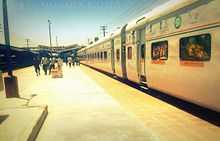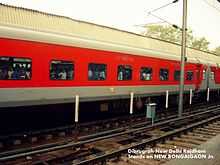New Bongaigaon
| New Bongaigaon নতুন বঙাইগাঁও | |
|---|---|
| City | |
| Nickname(s): City of Railway | |
 New Bongaigaon Location in Assam, India | |
| Coordinates: 26°28′41″N 90°33′40″E / 26.478°N 90.561°ECoordinates: 26°28′41″N 90°33′40″E / 26.478°N 90.561°E | |
| Country |
|
| State | Assam |
| Region | Western Assam |
| District | Bongaigaon |
| Zone | 1 |
| Bongaigaon Municipal Board | 29 September 1989 |
| Founded by | Government of Assam |
| Government | |
| • Type | Mayor–Council |
| • Body | Bongaigaon Municipal Board |
| • Deputy Commissioner | S.P Nandi, (IAS) |
| • Superintendent | N Gogoi, (IPS) |
| Area | |
| • City | 874 km2 (337 sq mi) |
| Elevation | 36 m (118 ft) |
| Population | |
| • City | 1,74,810 (incl Bongaigaon) |
| • Rank | 117th in India |
| • Metro | 1,09,863 (3rd) |
| Languages | |
| • Official | Assamese, English, Bengali |
| Time zone | IST (UTC+5:30) |
| PIN | 783381 |
| Telephone code | 03664 |
| Vehicle registration | AS-19 |
| Sex ratio | 912 per 1000 male (Census 2011) ♂/♀ |
| Legislature type | Railway Town |
| Planning agency | 9 |
| Distance from Delhi | 1,250 kilometres (780 mi) |
| Distance from Mumbai | 1,900 kilometres (1,200 mi) |
| Climate | Semi-Arid (Köppen) |
| Precipitation | 1,717.7 millimetres (67.63 in) |
| Avg. annual temperature | 26 °C (79 °F) |
| Summer temperature | 38 - 40 °C |
| Winter temperature | 33 - 28 °C |
| Website |
newbongaigaon |
| † Estimated as on 2014 | |
New Bongaigaon ![]() i/bɒŋɡɑːɪˈɡɒ̃ʊ/; (Assamese: বঙাইগাওঁ) is a city in the Indian state of Assam. The City included or new part of municipal board of Bongaigaon District. The town, divided into two parts – Old Bongaigaon and New Bongaigaon, is situated 180 kilometres (112 mi) north west of Guwahati. To meet the demands of Bodos of Assam, Bongaigaon was divided up to give way for Chirang district. Bongaigaon has a major petrochemical industry, the Indian Oil Corporation Limited[1][2] (IOCL BGR[3]).
i/bɒŋɡɑːɪˈɡɒ̃ʊ/; (Assamese: বঙাইগাওঁ) is a city in the Indian state of Assam. The City included or new part of municipal board of Bongaigaon District. The town, divided into two parts – Old Bongaigaon and New Bongaigaon, is situated 180 kilometres (112 mi) north west of Guwahati. To meet the demands of Bodos of Assam, Bongaigaon was divided up to give way for Chirang district. Bongaigaon has a major petrochemical industry, the Indian Oil Corporation Limited[1][2] (IOCL BGR[3]).
The town occupied a place in the map of Indian Railway with the establishment of the railway station in the year 1908. Most of the institutions like ITI, Bongaigaon College, Office of the Assam State Electricity Board[4][5] in the early 60’s and in fact the very base of the development of the town was laid in this decade only. The development further gained momentum with the establishment of the Bongaigaon Refinery and Petrochemicals Limited[6] (BRPL)[7] Complex in the year 1972 at Dhaligaon and also Thermal Power Plant at Salakati. Though these area are not within the limit of Bongaigaon Municipality the town also caters to the demand of this population. The Bongaigaon Town Committee was first constituted in the year 1961 and was upgraded to a Municipal Board in the year 1977. Presently the Municipal Area consists of 25 nos. of wards covering an area of 14.31 sq m.
Railways
Bongaigaon falls under the Northeast Frontier Railway zone of the Indian Railways.There are two stations in Bongaigaon - New Bongaigaon railway station (2nd largest railway junction of Assam state) and Bongaigaon (old) station. Major trains serving Bongaigaon with major cities are Guwahati Rajdhani Express, Poorvottar Sampark Kranti Express, Saraighat Express, Brahmaputra Mail, North-East Express, Guwahati Bangalore Express, Guwahati Ernakulam Express, Kamrup Express. It is the largest station in Western Assam after Guwahati. According to 2012 budget, New Bongaigaon Jn. is considered to be the Adarsh Station of India.


Construction of the 265 km (165 mi) long 1,676 mm (5 ft 6 in) wide broad gauge Siliguri-Jogihopa line, between 1963 and 1965, brought broad gauge railways to Assam. It also was the reason for setting up the New Bongaigaon railway station.[8]
New railway track from New Bongaigaon to Guwahati was commissioned in 1984.[9]
Saraighat Bridge opened in 1962, initially carried a metre gauge track, which was later replaced by broad gauge.[10]
Electrification of New Bongaigaon Rly. Jn.
Electrification of the Barauni-Katihar-Guwahati line was sanctioned in 2008.[11] In the document on Vision 2020 – A Blue Print for Railway Electrification Programme, in the list of ongoing projects the entire route km (836) is shown as balance work as on 1 April 2010.[12] The entire electrification project is scheduled to be completed by October, 2015.[13]
See also
- Bongaigaon Municipal Board
- List of cities in Assam by population
- List of cities in the North East and the Andaman and Nicobar Islands by population
- Bir Chilarai Flyover, Bongaigaon City
- New Bongaigaon railway station
References
- ↑ "Global 500". Fortune Global 500. Retrieved 31 Aug 2013.
- ↑ List of Maharatna, Navratna and Miniratna CPSEs |. Dpe.nic.in. Retrieved on 2013-07-28
- ↑ http://www.business-standard.com/article/companies/ioc-raises-500-mn-in-dollar-bond-issue-113072900513_1.html
- ↑ http://assamgovt.nic.in/departments/electricity_dept.asp
- ↑ http://www.emt-india.net
- ↑ http://www.swaminomics.org
- ↑ http://www.brplindia.com
- ↑ Moonis Raza & Yash Aggarwal. "Transport Geography of India: Commodity Flow and the Regional Structure of Indian Economy". page 60. Concept Publishing Company, A-15/16 Commercial Block, Mohan Garden, New Delhi - 110059. ISBN 81-7022-089-0. Retrieved 12 May 2013.
- ↑ "IR History: Part V (1970-19950". IRFCA. Retrieved 12 May 2013.
- ↑ "50 years of Saraighat bridge". The Times of India, 7 November 2012. Retrieved 12 May 2013.
- ↑ "CCEA approves Rs. 506 crores for Barauni-Katihar-Guwahati section". Projects Today. Retrieved 12 May 2013.
- ↑ "Vision 2020 – A Blue Print for Railway Electrification Programme" (PDF). Ministry of Railways, Government of India. Retrieved 12 May 2013.
- ↑ "Rajya Sabha unstarred question no. 1677 to be answered on 7 December 2012". Ministry of Railways. Retrieved 12 May 2013.
External links
| Wikimedia Commons has media related to Bongaigaon. |